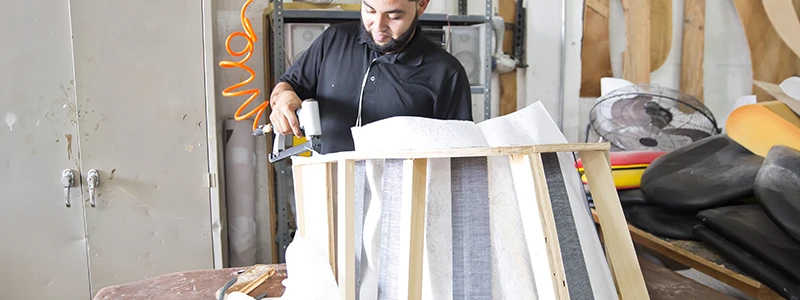How to become an Upholsterer

Upholsterers select, cut, sew and fit fabric or leather materials to furniture and repair damaged furniture.
Personal requirements for an Upholsterer
- Enjoy practical and manual activities
- Able to work neatly and accurately
- Able to work independently or as part of a team
- Interested in furniture
- Able to cope with the physical demands of the job
- Normal colour vision
- Good hand-eye coordination
Education & Training for an Upholsterer
To become an upholsterer you usually have to complete an apprenticeship. Entry requirements may vary, but employers generally require Year 10.
Duties & Tasks of an Upholsterer
Upholsterers:
- Discuss colour, fabric, style and cost of upholstery with clients
- Repair upholstered furniture by replacing covers, webbing, padding and springs
- Staple lengths of webbing (a wide tape) on to the underside of the furniture frame
- Stretch webbing from side to side, interlacing it to form a base for the padding
- Lace tops of springs together to prevent sideways movement and staple hessian to the frame
- Cut and fit foam padding
- Measure and cut covering material, join sections and tack fabric onto the furniture frame
- Cover staples with decorative braid, trim, buttons or nails and attach calico to the underside of the furniture.
Tasks
- May finish wooden surfaces on furniture
- Measuring and cutting materials and covering furniture
- Seaming cushions and joining sections of covering material
- Securing material, padding, springs and webbing to articles to be upholstered
- Conferring with clients to determine materials and cost of furniture items to be made or repaired
- Making and repairing wooden frames, and removing and replacing defective springs
- Removing coverings, webbing and padding from old furniture
- May remove stains from fabric
- Padding and covering spring units to upholster mattresses
- Attaching ornamental trims, braids and buttons
Working conditions for an Upholsterer
Upholsterers generally work in workshops but occasionally may be required to work in clients' homes or other sites. Upholsterers stand for most of the day, as the furniture is normally placed on a benchtop while work is carried out.
Employment Opportunities for an Upholsterer
Upholsterers are employed by furniture makers in the production of commercial, household, marine and caravan furniture. Most furniture upholsterers work in factories making new furniture. Some work in small businesses, where they may undertake antique, customised, renovation, repair and recovery work, or combine repair and manufacture. Those specialising in restoration work require knowledge of old and modern techniques. Opportunities for self-employment are greater in restoration work.
Specializations
Upholsterers may work in one or more of four main fields:
- Antique and Reproduction Upholstery - involves restoring genuine antiques or recreating the style of a certain era in history.
- Custom Upholstery - involves building furniture for special purposes, such as for use in hotels, ships and airports.
- Production Upholstery - involves upholstering mass-produced furniture in sections for the domestic or commercial market.
- Renovation and Repair Upholstery - involves replacing old and damaged upholstery.
Upholsterer
Upholsterers select, cut, sew and fit fabric or leather materials to furniture and repair damaged furniture.

Average age
49 years

Future Growth
Decline

Gender Share
9% female

Average full-time
43 hours

Weekly Pay
Unavailable

Skill level rating
Medium skill

Unemployment
Lower unemployment

Full-Time Share
78% Full-Time

Employment Size
2,000 workers

Employment by state
ACT: 0.7%
NSW: 29.0%
NT: 0.7%
QLD: 19.8%
SA: 7.3%
TAS: 2.4%
VIC: 29.6%
WA: 10.4%
Age brackets
15-19: 1.6%
20-24: 5.4%
25-34: 11.4%
35-44: 19.5%
45-54: 29%
55-59: 14.8%
60-64: 11.7%
65 and Over: 6.6%
Education level
Advanced Diploma/Diploma: 2.9%
Bachelor degree: 2.6%
Certificate III/IV: 58%
Post Graduate/Graduate Diploma or Graduate Certificate: 0.1%
Year 10 and below: 18.8%
Year 11: 4.8%
Year 12: 12.6%
